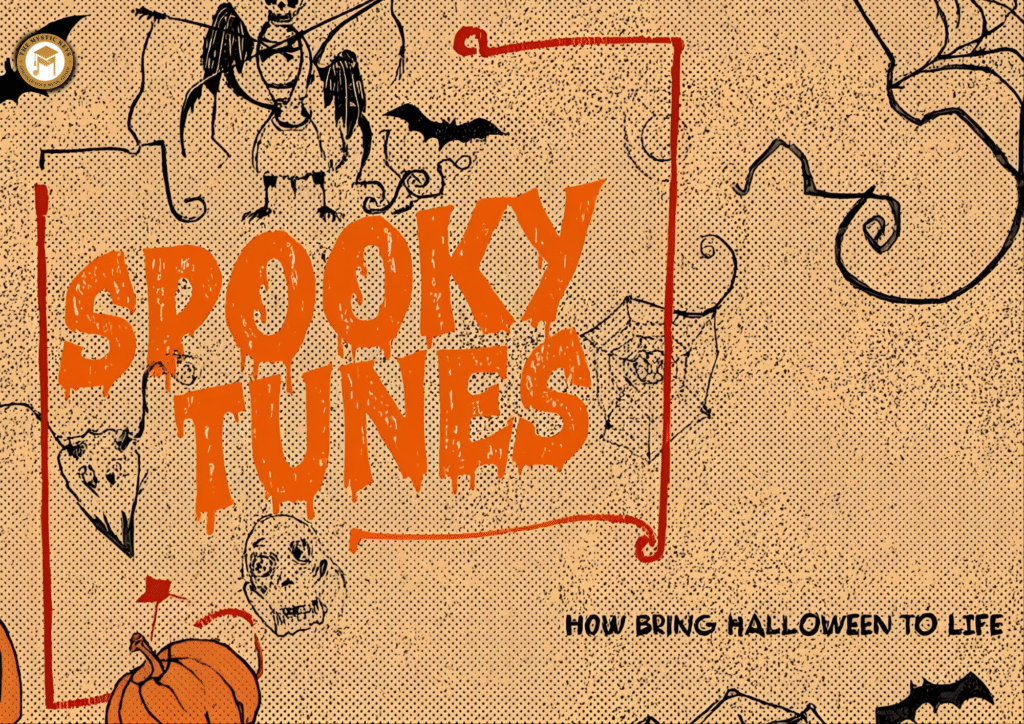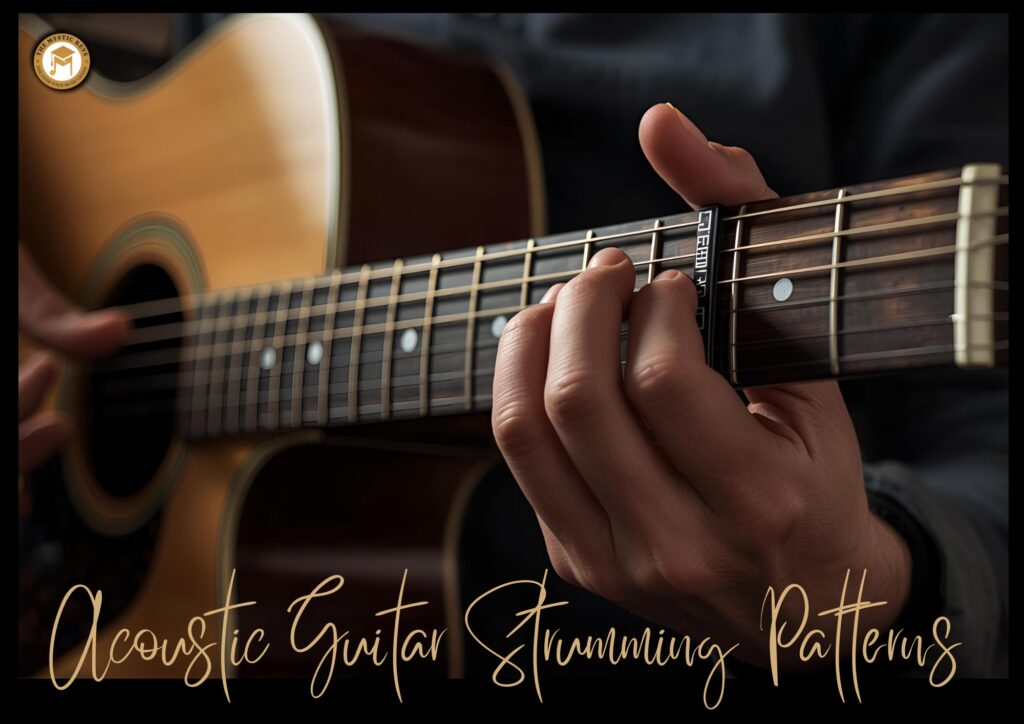
Acoustic Guitar Strumming Patterns | Best Rhythms for Beginners
Acoustic Guitar Strumming Patterns | Best Rhythms for Beginners
When you first pick up an acoustic guitar, the excitement of learning your favorite songs can easily take over, drawing your attention to chords and melodies. Yet, as you begin playing, you quickly realize that while chords form the foundation of music, it’s Acoustic Guitar Strumming that truly breathes life into those chords. The rhythm of your right hand doesn’t just keep time — it shapes the energy, mood, and emotion of every song, giving your playing personality and feeling.
Whether you’re strumming through soft ballads, upbeat pop songs, or soulful worship tunes, developing consistent strumming patterns is essential for transforming simple chords into music that resonates. By understanding and practicing these patterns, you not only improve your timing but also gain control, flow, and confidence, making your playing sound polished and expressive. In this guide, we’ll walk you through some of the best acoustic guitar strumming patterns for beginners, showing you how to build solid rhythm, smooth transitions, and the expressive touch that can elevate your music from basic chords to captivating songs.
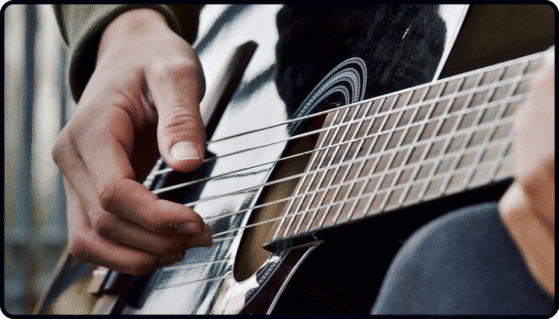
Why Acoustic Guitar Strumming Patterns Matter
Every guitarist dreams of sounding effortless — the kind who can play a simple chord progression and still make it feel good. Interestingly, the secret isn’t in mastering complex chords or flashy techniques; it lies in the rhythmic consistency of your strumming hand, which truly gives life to your playing.
Think of strumming as the heartbeat of your music. Even if you only know a handful of chords, the right rhythm can completely transform them, turning a simple sequence into a captivating melody. A smooth, consistent strum not only:
Keeps your timing steady, making sure each beat falls naturally,
Adds groove and dynamics that bring energy and emotion to your performance, and
Helps you connect deeply with the song, so that both you and your audience feel its pulse.
Before diving into specific acoustic guitar strumming patterns, there’s an essential principle to understand: your strumming hand should never freeze. Even during pauses, chord transitions, or moments of hesitation, it should maintain a flowing, rhythmic motion. This continuous movement is what separates a beginner from a confident guitarist, allowing your music to sound polished and expressive even as you’re still learning.
By internalizing this rhythm-first mindset in acoustic guitar strumming, you’re laying the foundation not only for mastering patterns but also for developing your own musical style and personal expression.
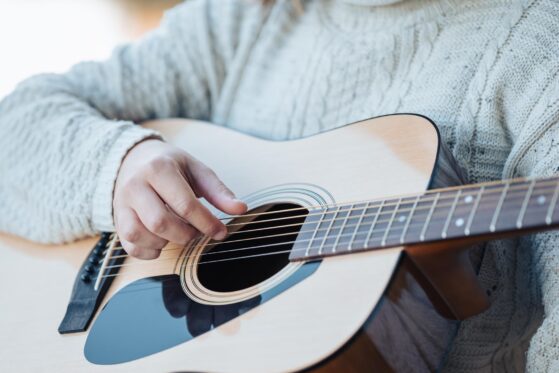
Understanding Basic Acoustic Guitar Strumming
Every strumming pattern — no matter how complex — is built from two simple motions:
Downstroke (↓) – Strumming downward, hitting the thicker strings first.
Upstroke (↑) – Strumming upward, lightly brushing the thinner strings.
Most songs use a 4/4 time signature, meaning there are four beats in each measure. Try counting out loud:
1 – 2 – 3 – 4
Now, strum down once on each beat:
↓ ↓ ↓ ↓
This might seem simple, but it’s the best place to start. This foundational rhythm teaches your hand how to stay in time — something you’ll need for every pattern ahead.
Once this feels natural, you’re ready to add upstrokes and create more musical variety.

The Classic Down-Up Pattern (↓ ↓ ↑ ↑ ↓ ↑)
Now that you can maintain a steady beat, let’s add some motion and groove.
The Down-Down-Up-Up-Down-Up pattern is one of the most popular strumming patterns of all time. You’ll find it in pop, rock, country, and even folk songs.
Pattern:
↓ ↓ ↑ ↑ ↓ ↑
Try it with chords like G – C – D – Em. Start slowly, then gradually increase your speed as you gain control.
Transition tip: Don’t just move your arm mechanically — keep your wrist loose and your motion continuous, even when you’re not striking the strings. That smooth, circular motion is what gives this pattern its flow.
The Down-Down-Up Pattern (↓ ↓ ↑ ↓ ↑)
Once you’ve got the hang of the previous rhythm, let’s simplify things slightly while keeping the energy alive.
Pattern:
↓ ↓ ↑ ↓ ↑
This one creates a natural folk-pop rhythm, ideal for sing-alongs and campfire-style playing. It’s a perfect balance between structure and fluidity — not too simple, not too complex.
Try it with C – Am – F – G, and notice how it gives your song a steady pulse with just a hint of swing.
This pattern is especially helpful when transitioning between open chords, allowing your left hand time to move without breaking rhythm.
Island Acoustic Guitar Strumming (↓ ↓ ↑ ↑ ↓ ↑)
Next, let’s add a bit of a tropical feel.
Known as the “island strum,” this pattern brings a breezy, upbeat rhythm reminiscent of beachside tunes and feel-good pop.
Pattern:
↓ ↓ ↑ ↑ ↓ ↑
Yes, it looks similar to the classic down-up pattern, but the way you accent certain beats makes all the difference. Emphasize the first downstroke, let the upstrokes flow lightly, and you’ll instantly get that island vibe.
Try playing C – G – Am – F while tapping your foot to the beat — it’s impossible not to smile while strumming this one!
The Down-Down-Down-Up Pattern (↓ ↓ ↓ ↑)
As your rhythm control improves, you can experiment with patterns that allow for emotional dynamics.
Pattern:
↓ ↓ ↓ ↑
This one works beautifully for slower ballads, worship songs, or acoustic pop. The three downstrokes give a steady foundation, and the final upstroke adds lift at just the right moment.
It’s great for songs that need space between strums — allowing your voice or melody to shine through.
To enhance it further, play around with volume: try softer downstrokes and a slightly brighter upstroke to create natural movement.
The Pop Groove (↓ ↓ ↑ ↑ ↓)
If you love modern acoustic songs, you’ll enjoy this next pattern.
Pattern:
↓ ↓ ↑ ↑ ↓
It gives a tight, rhythmic groove that fits perfectly with pop, soft rock, and indie tracks. It’s slightly syncopated — meaning the emphasis doesn’t always land on the strong beats — giving your playing a more professional edge.
As you practice, you’ll begin to “feel” the spaces between strums. That’s when you start sounding less like a beginner and more like a performer.
Bonus | Percussive Acoustic Guitar Strumming
Once you’re confident with the patterns above, try adding some rhythmic spice using percussive mutes.
Here’s how: after a downstroke, lightly rest your strumming hand on the strings to stop the sound — creating a subtle “chuck” sound.
Pattern example:
↓ (mute) ↓ ↑ (mute) ↑ ↓
This technique instantly gives your strumming a drum-like rhythm, adding groove and character to your sound. It’s often used in funk, pop, and acoustic rock.
Bringing Rhythm and Transitions Together
By now, you’ve probably noticed that each new pattern builds on the last. The real magic happens when you start transitioning smoothly between them — for instance, switching from a Down-Down-Up pattern in one verse to an Island Strum in the chorus.
This variety keeps your playing fresh and expressive. It also trains your hand to stay flexible — an essential skill for accompanying singers or performing live.
Try this exercise:
Play G – C – D using ↓ ↓ ↑ ↓ ↑ for one verse.
Then switch to ↓ ↓ ↑ ↑ ↓ ↑ for the chorus.
Notice how the energy shifts naturally with the rhythm.
These transitions are what make your music feel alive.

Tips for Mastering Strumming Patterns
Smooth transitions and clean rhythms take time — but here’s how to make the process easier:
Use a Metronome or Drum Loop:
Always practice with a steady beat to train your sense of timing.Keep Your Wrist Loose:
Strumming comes from the wrist, not the arm. Relaxed motion equals smoother rhythm.Count Aloud:
Counting “1 & 2 & 3 & 4 &” helps lock your strokes with the beat.Play Along with Real Songs:
This is one of the best ways to internalize rhythm naturally.Focus on Flow, Not Perfection:
It’s okay if your hand hits extra strings — what matters is staying in time.
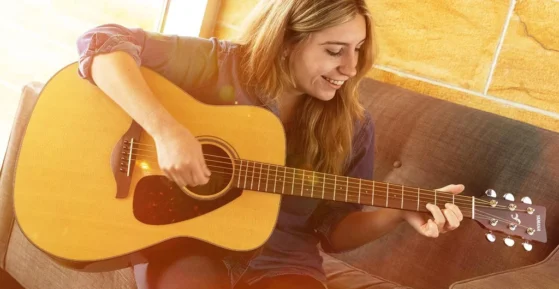
Build Your Own Acoustic Guitar Strumming Style
After a few weeks of consistent practice, you’ll notice something wonderful — strumming starts to feel natural, and your hand begins to move almost instinctively with the rhythm of the song. The patterns you once carefully counted will blend together effortlessly, and you’ll start adding subtle pauses, accents, and rhythmic variations that reflect both the emotion of the music and your own interpretation.
As your confidence grows, you’ll gradually move beyond simply following set patterns. You may begin experimenting with slight tempo changes, mixing different patterns, or emphasizing certain beats to make the rhythm uniquely yours. This stage marks the exciting shift from learning to playing creatively, where your strumming begins to reflect your personal style and musical voice.
This evolution — from mimicking rhythms to expressing your own ideas — is a defining moment for any guitarist. It’s where practice transforms into artistry, and where your music starts to truly come alive. By embracing this stage, you gain not only technical skill but also the freedom to play with emotion, confidence, and originality, making each song distinctly yours.

Ready to Take the Next Step?
Once you’ve built confidence with these beginner patterns, the next step is to expand your musical horizons. You can explore advanced rhythm techniques, fingerstyle playing, or percussive acoustic styles, each adding new layers of creativity and expression to your playing. With every new pattern you learn, your sense of timing sharpens, your strumming becomes more dynamic, and your overall confidence as a guitarist grows.
At The Mystic Keys, our online guitar lessons are carefully structured to guide you through this journey step by step. From mastering the fundamentals of rhythm to developing expressive strumming, improvisation, and advanced techniques, we ensure you progress smoothly while enjoying every moment of learning.
Master Acoustic Guitar from basic to advanced with our Guitar Lessons Online. Let each strum reflect your unique style and bring your music to life — because your rhythm deserves to be heard and felt.
For more information and exciting resources about learning music, visit our website at The Mystic Keys. For more music content and exciting offers follow us on
Facebook, Instagram, YouTube, LinkedIn, Twitter, Pinterest, and Threads.


